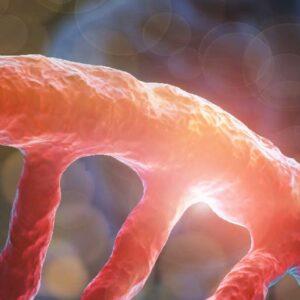Scientific Background
Alport syndrome (ATS) is a progressive hereditary nephropathy that occurs with a frequency of approximately 1:5,000. Initial clinical signs are proteinuria and hematuria, but patients develop end stage renal disease (ESRD) as the disease progresses. In addition, extrarenal manifestations such as early onset sensorineural hearing loss and ocular changes (anterior lenticonus) are observed. Males are usually more severely affected. The course is very variable in females and can vary from an inconspicuous phenotype to full-blown Alport syndrome. Alport syndrome is caused by changes in type IV collagen, which lead to structural defects in the glomerular basement membrane.
Three genes have so far been identified as being the genetic cause: COL4A3, COL4A4 and COL4A5. For the COL4A3 gene and the COL4A4 gene both an autosomal recessive inheritance (AR-ATS, frequency: about 15% of all ATS patients) and an autosomal dominant inheritance (AD-ATS, frequency: about 1-5% of all ATS patients) have been described. However, according to the expert guideline of Savige et al. 2019, a consensus on the use of the term AD-ATS in individuals with heterozygous COL4A3 or COL4A4 variants is lacking, as most patients do not have hearing loss, ocular abnormalities or glomerular basement membrane (GBM) lamellation and only a few develop end-stage renal failure. However, the prognosis is not necessarily benign, as a small but unpredictable number of patients suffer from kidney failure. The expert consensus guidelines continue to advocate the use of the term thin basement membrane nephropathy (TBMN) for dominant inheritance. Patients with TBMN are also considered carriers of AR-ATS. Pathogenic variants in the COL4A5 gene lead to X-linked ATS (frequency: about 85% of cases). However, polymorphic COL4A5 variants could also be detected, which in some cases can cause the phenotype of TBMN instead of ATS.
The genetics of Alport syndrome is complicated because different combinations of variants can occur in the three collagen type IV genes, as well as digene variants in these three genes and other podocyte genes that can potentially influence the phenotype. Three NGS studies (by different laboratories) have confirmed that the type of inheritance is clinically difficult to predict. For this reason, all three genes, COL4A5, COL4A3 and COL4A4, are recommended for investigation in suspected Alport syndrome.
In X-linked chromosomal disease, about 40% of all variants are missense alterations, 10% are splice variants, 7% are nonsense variants and another 30% lead to a frameshift. This means that almost 40% of all variants cause a premature stop codon. A similar distribution of pathogenic variants is also observed in autosomal recessive disease. There are no hot spot regions in the affected genes other than glycine residues in the triple helical domain and glycine substitutions in this region are the most common changes. They are usually pathogenic because glycine is the smallest amino acid and the exchange with a larger amino acid disrupts the triple helical structure. Only a few glycine substitutions are not pathogenic.
Variants in the COL4A3, COL4A4 and COL4A5 genes are also detected in more than 30% of patients with adult focal segmental glomerulosclerosis (FSGS).
References
Savige et al. 2019, Pediatr Nephrol 34:1175 / Mencarelli et al. 2015, J Med Genet 52:163 / Rosado et al. 2015, Kidney Blood Press Res 40:435 / Hertz et al. 2014, Eur J Hum Genet 23:e1 / Savige et al. 2013, J Am Soc Nephrol 24:364 / Pierides et al. 2013, Hippokratia 17:207 / Savige et al. 2013, J Am Soc Nephrol 24:364





















